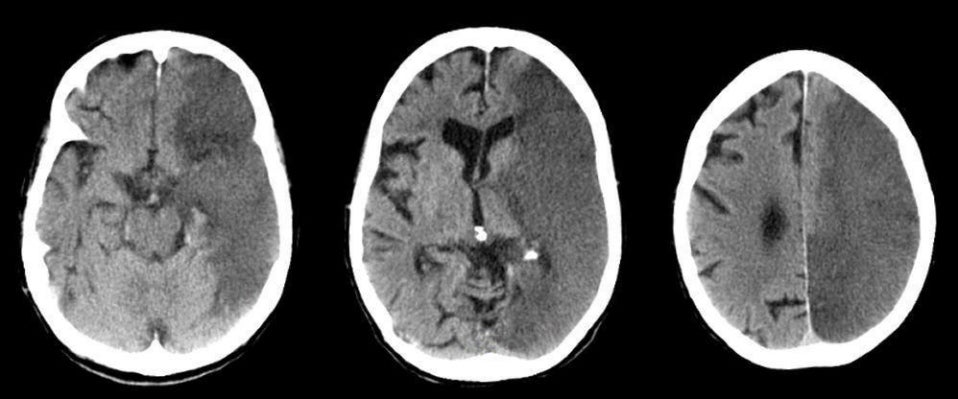
|
A 75 year-old woman with atrial fibrillation presented with the acute onset of global aphasia, right hemiplegia, and dense right visual field cut. |

![]()
![]()
| Proximal Stem Middle Cerebral Artery (MCA) with a Persistent
Fetal Circulation Infarction:
Axial CT scans 2 days after presentation. Note the large hypodensity
involving the distribution of the entire middle cerebral artery as
well as the deeper basal ganglia. The involvement of the basal
ganglia denotes that the blockage occurred at the proximal middle
cerebral artery stem, before the take off of the small perforating
vessels that supply the basal ganglia. Lastly, note that the left
occipital lobe (posterior cerebral artery territory) is also infarcted. Although this could represent a separate embolus to the
posterior cerebral artery, the more likely explanation is that the
patient had a persistent fetal circulation on the left side, a
normal anatomic variant wherein the posterior cerebral artery arises
directly from the posterior communicating artery off the internal
carotid artery. Thus, an embolus at the top of the internal carotid
artery can then infarct the middle cerebral and posterior cerebral
artery territories.
The internal carotid artery terminates in a larger MCA and smaller anterior cerebral artery. The MCA runs horizontally to the Sylvian fissure, giving off the lenticulostriate vessels. These small perforating vessels supply the basal ganglia and internal capsule. The MCA then typically bifurcates into a superior and inferior division. The superior division supplies the lateral frontal and superior parietal lobes, whereas the inferior division predominantly supplies the lateral temporal and inferior parietal lobes. Occlusions of the proximal stem of the MCA affect both the superior and inferior divisions, as well as the lenticulostriates. Complete infarctions on the distal MCA stem result in a contralateral hemiplegia (face, arm AND leg); contralateral hemisensory loss; and a contralateral visual field deficit. With an infarct in the dominant hemisphere, there is often an associated global aphasia (expressive and receptive); with a non-dominant infarct, there is often a neglect syndrome and impairment of visuospatial skills (e.g., drawing, copying, dressing). The major clinical difference between a proximal and distal MCA stem occlusion is that with a proximal lesion the leg is plegic as well. This occurs because the lenticulostriates are involved, which results in infarction of the internal capsule, which contains fibers to the leg, arm and face. |
Revised
11/15/06
Copyrighted 2006. David C Preston